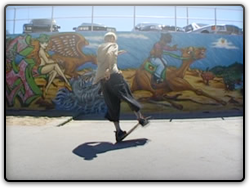Use a video camera, mobile phone, webcam or another type of digital video recorder to record the performance for the video artwork.
In your group discuss different ways of using your video recorder and how this might add to the meaning of the work.
You could try using:
-
a camera attached to the subject’s body to show the scene from the subject’s perspective as Gladwell did in Double Linework
-
a fixed, unobtrusive camera position that will record a specific area and any incidental movement as in Kickflipper
-
a number of cameras, each focused on a different area of the performance space. As the subject moves within the space, different cameras will capture the action in their viewing area
-
direct sound (the sound happening as you record) or adding sound (make sure that any sound you add is copyright free)
-
ideas of your own.
You could use Adobe Premier Elements to edit your video artwork. Think carefully about how your editing might enhance the:
-
group’s intention
-
meaning of the artwork
-
video as an artwork.
You might:
-
change the timing of the video. Gladwell used slow motion in Kickflipper, giving viewers more time to observe detail
-
experiment with different ways to change from one trick or movement to another. Gladwell used black out in Kickflipper
-
rotate the video so that it is viewed upside down. Gladwell did this in Tangara so that the subject seems to be defying gravity
-
ideas of your own.

SHAUN GLADWELL Kickflipper (video still), 2010